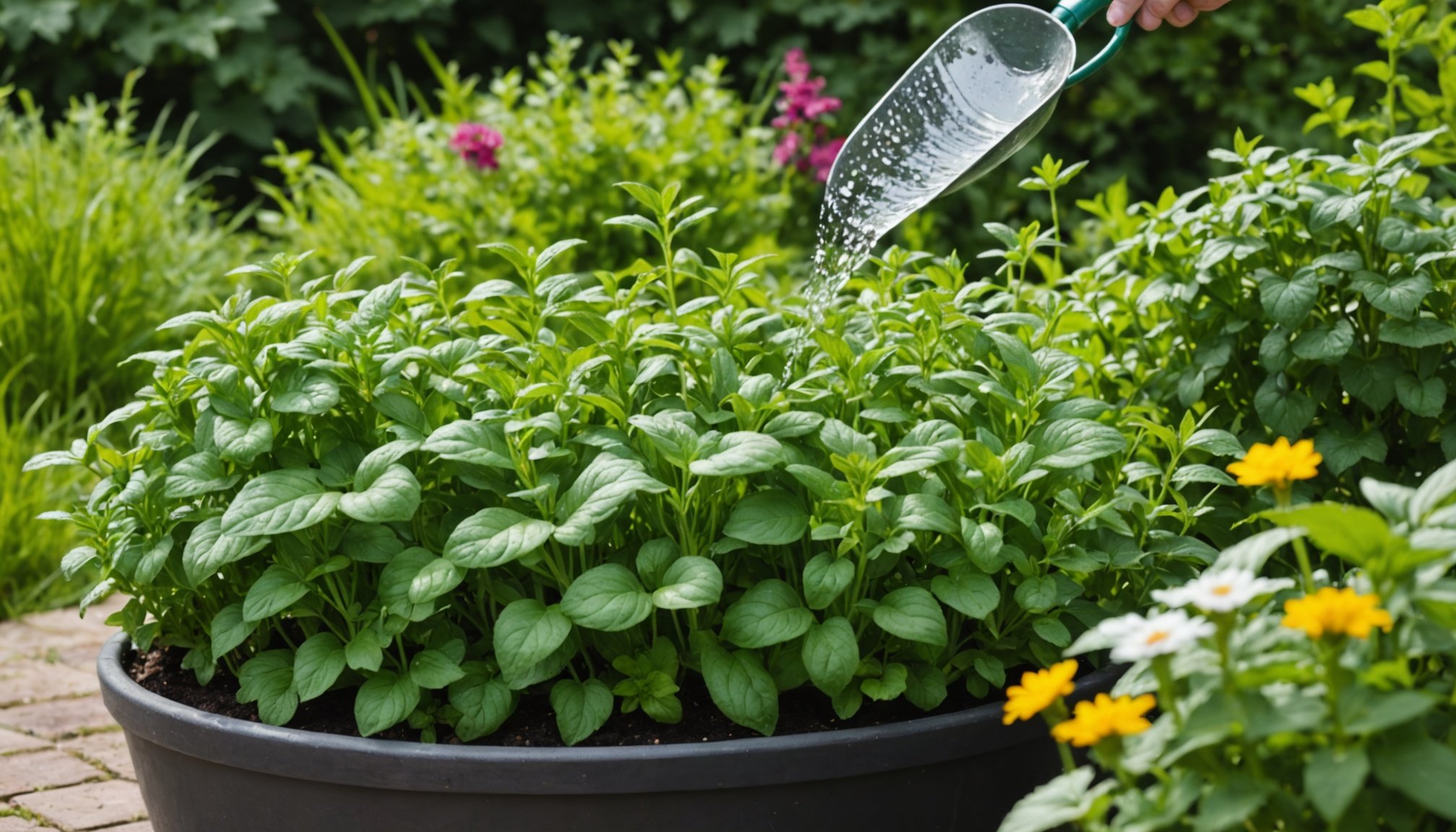Effective Watering Techniques for Herb Gardens
Understanding watering techniques is crucial for maintaining a healthy herb garden. Herb garden care often begins with assessing water requirements tailored to each type. Implementing effective methods not only enhances plant health, but also promotes sustainable growth.
Importance of Proper Watering
Each herb possesses unique water needs, which is integral to its growth and health. Overwatering or underwatering can stunt growth, lead to disease, or cause plant death. Thus, recognising precise requirements is vital for effective herb garden care.
Dans le meme genre : Mastering Peony Cultivation: Essential Tips for Thriving in the UK”s Humid Climate
Watering Methods in the UK
For UK herb gardens, employing efficient irrigation methods ensures that plants receive sufficient moisture. Traditional practices like hand watering allow for control and precision, suitable especially in small gardens or pots. Alternatively, automated systems such as drip irrigation offer consistent watering schedules, reducing human error and conserving water.
Benefits of Efficient Watering
An efficiently watered herb garden often results in higher crop yields. By providing just the right amount of water, herbs will produce more robust and flavourful yields. Moreover, adopting sustainable watering techniques helps conserve water resources, ensuring both environmental responsibility and healthier plants. Adhering to effective watering strategies guarantees that your herbs flourish, offering bountiful harvests season after season.
Lire également : Top Native UK Plants That Draw Beneficial Insects for Effective Organic Pest Management
Timing and Frequency of Watering
Understanding the watering schedule for your herb garden is pivotal to ensuring healthy growth and optimal moisture levels. It’s crucial to water herbs either early in the morning or late afternoon to maximise moisture retention. This approach minimises evaporation, ensuring that the plants receive sufficient hydration to thrive.
The frequency of watering mainly depends on prevailing weather conditions. During cooler months, herbs may require watering as infrequently as every 3 to 5 days. However, as temperatures rise, the need for more frequent irrigation becomes apparent. Observing seasonal watering patterns allows gardeners to adjust their routines accordingly.
In periods of hot and dry weather, it might be necessary to increase the frequency of the herb garden irrigation significantly. Checking soil moisture is a reliable method to determine the need for water; if the top inch feels dry, it’s time to water. Additionally, mulching can aid in retaining moisture and should be considered when adjusting watering schedules during prolonged heatwaves. By tailoring watering habits to both weather and garden specifics, herbs can be kept lush and vibrant year-round.
Regional Recommendations for Watering Herbs
Understanding climate variations across the UK is crucial for successful herb gardening. The country’s diverse weather patterns demand tailored regional gardening tips to ensure optimal growth. Here’s how to adapt your watering practices according to different herb gardening regions.
Specific Watering Guidelines
-
Scotland: With its wet, cooler climate, herbs often require less frequent watering. It’s important to allow the soil to dry slightly between waterings to avoid root rot.
-
South East England: This region usually experiences warmer and drier conditions. Regular watering is necessary, particularly during the summer months. Employing mulching techniques can help retain moisture in the soil.
-
Wales: Given its moderate rainfall, herbs need a balanced watering schedule. Be attentive to soil moisture levels, ensuring they remain consistently damp but not saturated.
Adapting to Climate Changes
With UK climate shifts becoming more prevalent, gardeners need to adjust their practices. Regularly monitoring weather forecasts and soil conditions helps you anticipate changes. Using efficient irrigation systems or rainwater harvesting can optimise water usage, making your garden more resilient to erratic weather patterns. These strategies ensure your herbs receive the right amount of moisture for thriving growth.
Adapting to Fluctuating Weather Conditions
Fluctuating weather conditions can present challenges for gardeners, especially when it comes to managing herb gardens. Recognizing the signs of overwatering versus underwatering is essential when adapting to weather changes. Overwatered herbs often display yellowing leaves and a mushy texture, while underwatered herbs may exhibit wilting and dry soil. Identifying these symptoms promptly is crucial for maintaining plant health.
When faced with sudden weather fluctuations, utilizing adaptive gardening strategies is key. Adjust your watering schedule by observing the weather forecast. For instance, during rainy periods, reduce watering to prevent overhydration. Conversely, increase watering frequency during dry spells to ensure adequate moisture. This proactive approach helps prevent stress on your plants.
Weather forecasts are invaluable tools for gardeners, offering guidance on planning effective watering strategies. By integrating this information into your gardening routine, you can better prepare for potential weather impacts and optimize herb garden care. Pay attention to predicted rainfall and temperature changes, adjusting your gardening practices accordingly. Incorporating these strategies not only enhances garden health but also promotes efficient resource use, contributing to a sustainable gardening approach.
Impact of Climate on Herb Growth
Understanding the climate effects on herb growth is crucial for any gardener aiming to cultivate a thriving herb garden. Different environmental factors such as temperature, humidity, and sunlight play significant roles in determining the growth patterns and watering needs of herbs. For instance, herbs like basil thrive in warm climates with ample sunlight, whereas mint prefers cooler, moist environments.
Selecting herb varieties according to your specific climate can greatly influence their success. Some herbs are adaptable to a wider range of conditions, while others are more sensitive. Recognising these climatic preferences allows gardeners to make informed decisions about which herbs are best suited for their garden’s environment.
To maintain herb vitality amidst climate variations, it’s essential to adopt specific best practices. Regular monitoring of soil moisture ensures that herbs receive adequate water; too much water in humid climates can lead to root rot, while too little in dry climates can stunt growth. Shade cloths can moderate excessive sunlight, while mulch helps retain soil moisture. Implementing these strategies not only preserves herb health but also maximises their growth potential, despite fluctuating climate conditions.
Maintenance Strategies for Optimal Garden Yield
Achieving an optimal garden yield requires effective garden maintenance strategies that ensure healthy growth and productive harvests. A crucial aspect of this is complementing effective watering with comprehensive maintenance techniques. For instance, regular pruning and weeding help reduce competition for resources among plants, which in turn enhances water absorption and nutrient uptake from the soil.
Mulching plays a vital role in maintaining soil health and water retention. By applying a layer of organic material, such as straw or wood chips, you can significantly reduce soil evaporation and suppress weed growth. This not only conserves moisture but also contributes to improved soil structure over time.
Incorporating expert insights into your routine is another crucial factor. By staying informed about the latest herb care tips and sustainable practices, you can continuously enhance your garden’s productivity. Resources such as gardening workshops or online forums provide valuable knowledge for tackling common issues and discovering innovative solutions.
To maintain a thriving garden, it is essential to implement maintenance strategies that focus on soil health, consistent water management, and ongoing education. By prioritising these elements, you can maximise your garden’s yield effectively.











